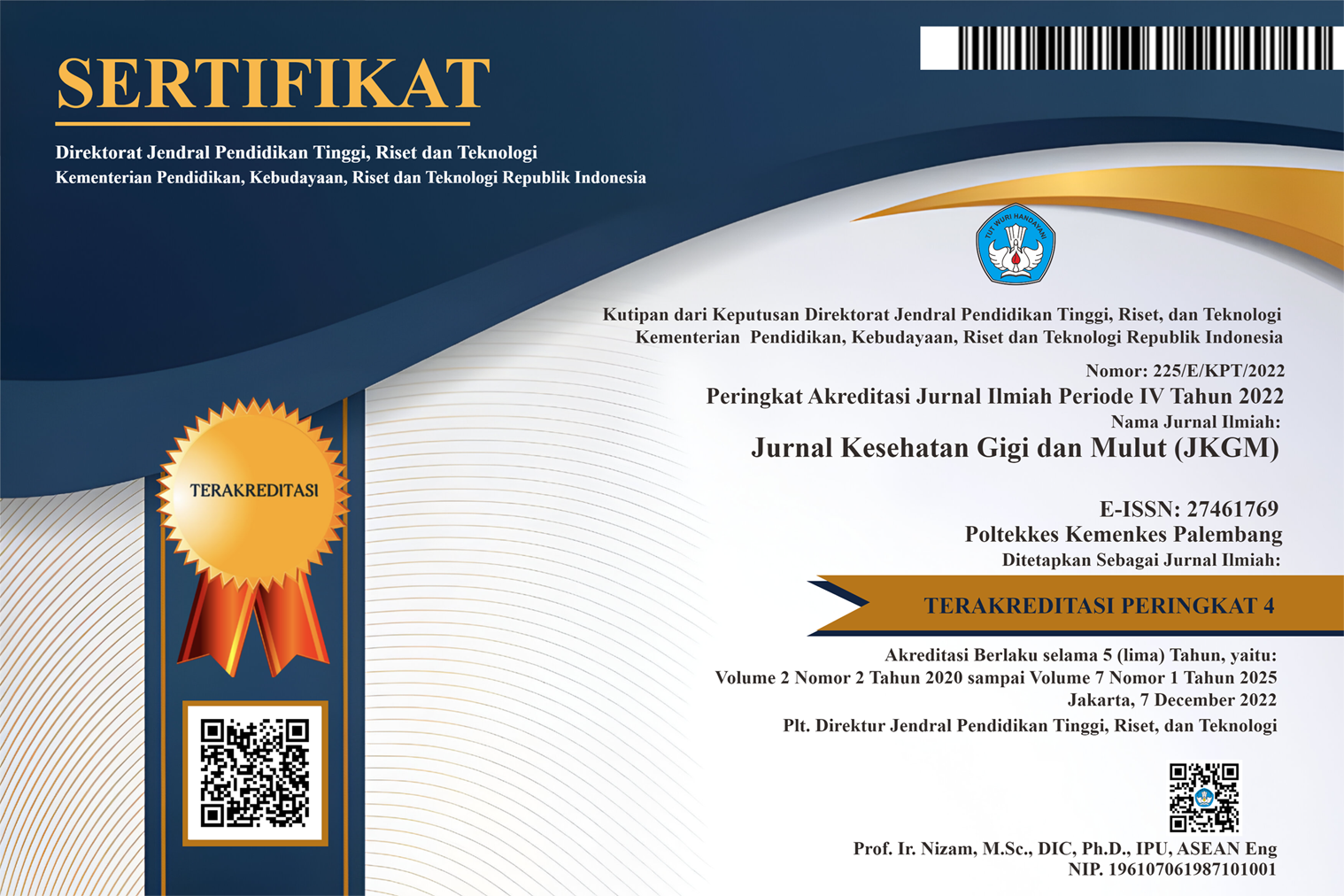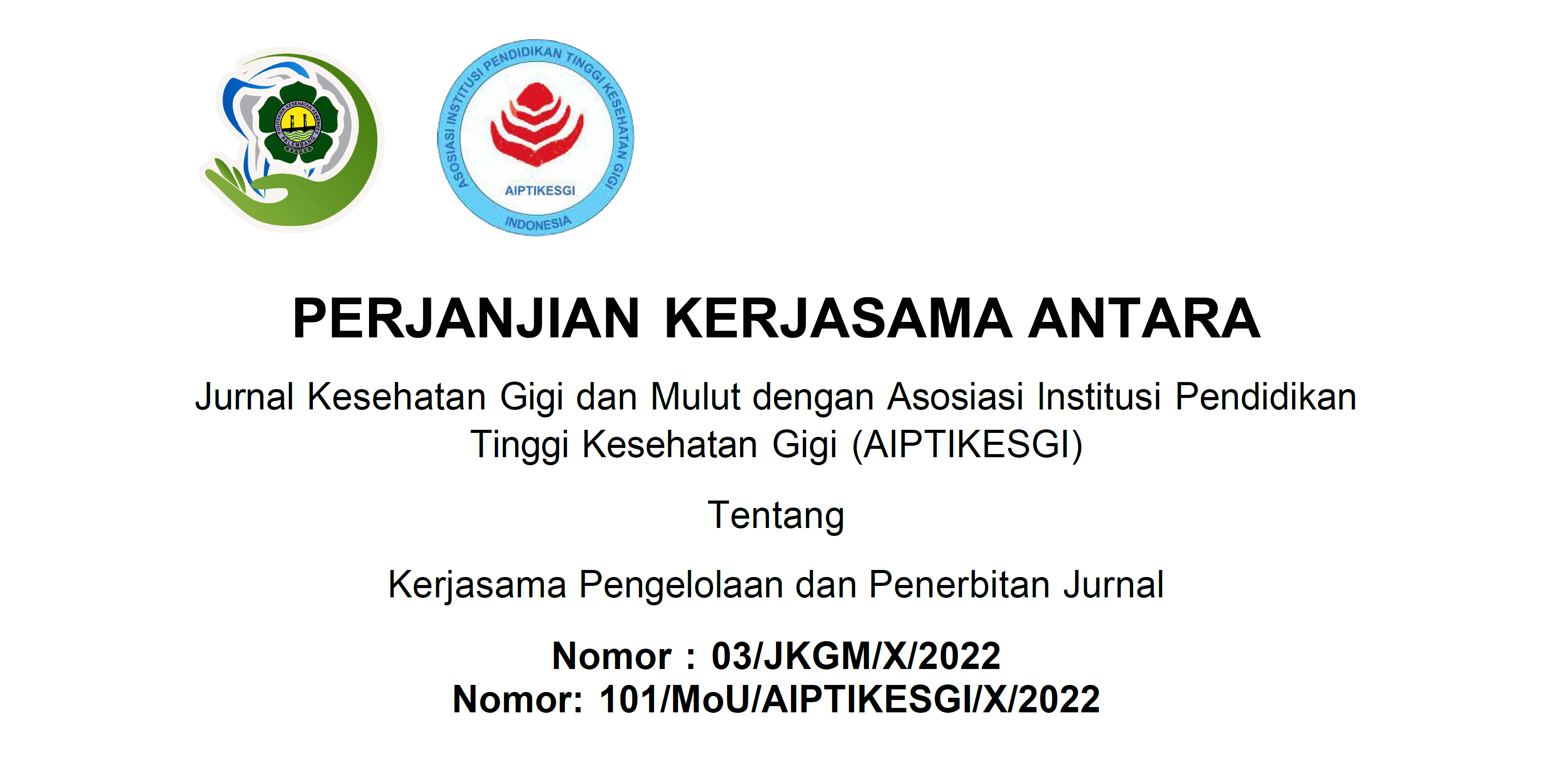PENGGUNAAN MYLAR MATRIX PADA RESTORASI KELAS III KOMPOSIT POST PERAWATAN INDIRECT PULP CAPPING: LAPORAN KASUS
Abstract
ABSTRAK
Latar Belakang: Keberhasilan restorasi direk komposit pada zona estetik memerlukan pemahaman komprehensif mengenai anatomi gigi, ilmu tentang warna dan material. Aspek paling menantang yaitu mendapatkan kontur yang tepat dan kontak proksimal yang rapat. Mylar matrix umum digunakan pada restorasi kelas III dan IV komposit yang dapat membantu mencapai kontur anatomi estetik yang ideal. Laporan kasus ini bertujuan memaparkan penggunaan Mylar matrix pada restorasi kelas III komposit post perawatan indirect pulp capping..
Laporan Kasus: Pasien perempuan usia 48 tahun datang dengan keluhan gigi berlubang pada kiri depan rahang atas dan terasa ngilu saat minum dingin, namun keluhan hilang saat stimulus dihilangkan. Pasien didiagnosis mengalami reversible pulpitis gigi 23, lalu dirawat dalam 3 kali kunjungan dengan restorasi kelas III komposit disertai aplikasi bahan pulp capping. Pada tahapan restorasi, Mylar matrix digunakan untuk membantu membentuk kembali kontur gigi tersebut.
Pembahasan: Mylar matrix digunakan pada restorasi komposit untuk membentuk dinding sementara saat permukaan proksimal gigi telah hilang. Matriks ini dapat membantu penempatan dan pembentukan bahan restorasi. Mylar matrix menawarkan keunggulan dalam kemudahan penggunaannya, tersedia secara luas, murah, membantu penyelesaian restorasi dalam waktu yang cepat, dan hasil yang baik.
Kesimpulan: Perawatan kasus pulpitis reversible dengan lesi karies dalam dengan indirect pulp capping dilanjutkan restorasi kelas III komposit dengan penggunaan Mylar matrix pada prosedurnya terbukti berhasil. Vitalitas pulpa terjaga tanpa keluhan subjektif dan pasien puas dengan hasil restorasi secara keseluruhan.
Kata kunci : Mylar matrix, restorasi kelas III komposit, indirect pulp capping
ABSTRACT
Background: The success of direct composite restorations in the esthetic zone requires a comprehensive understanding of tooth anatomy, color and material. The most challenging aspect is getting the contour right and the proximal contact tight. Mylar matrix is commonly used in class III and IV composite restorations that helps to achieve ideal aesthetic anatomical contours. This case report aims to explain the use of Mylar matrix in Class III composite restorations post indirect pulp capping treatment.
Case Report: A 48 year old female patient came with complaints of cavities in the left front of the upper jaw and felt sore when drinking cold drinks, but the complaints disappeared when the stimulus was removed. Patient was diagnosed with reversible pulpitis of tooth 23, and was treated in 3 visits with a class III composite restoration accompanied by the application of pulp capping material. At the restoration stage, Mylar matrix is used to reshape the contour of the tooth.
Discussion: Mylar matrix is used in composite restorations to form a temporary wall when the proximal surface of the tooth has been lost. This matrix can assist in the placement and shaping of restorative materials. Mylar matrix offers advantages in ease of use, widely available, cheap, helps complete restorations in a fast time, and good results.
Conclusion: Treatment of cases of reversible pulpitis with deep carious lesions with indirect pulp capping followed by class III composite restorations using Mylar matrix in the procedure has proven successful. Pulp vitality was maintained without subjective complaints and the patient was satisfied with the overall results of the restoration.
Key words: Mylar matrix, class III composite restoration, indirect pulp capping
Copyright (c) 2024 Jurnal Kesehatan Gigi dan Mulut (JKGM)

This work is licensed under a Creative Commons Attribution-ShareAlike 4.0 International License.
Authors who publish with this journal agree to the following terms:
- Authors retain copyright and grant the journal right of first publication with the work simultaneously licensed under a Creative Commons Attribution License that allows others to share the work with an acknowledgement of the work's authorship and initial publication in this journal.
- Authors are able to enter into separate, additional contractual arrangements for the non-exclusive distribution of the journal's published version of the work (e.g., post it to an institutional repository or publish it in a book), with an acknowledgement of its initial publication in this journal.
- Authors are permitted and encouraged to post their work online (e.g., in institutional repositories or on their website) prior to and during the submission process, as it can lead to productive exchanges, as well as earlier and greater citation of published work















